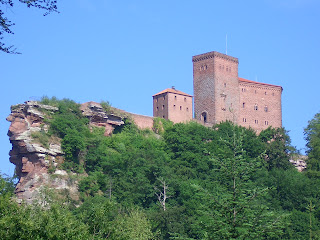This month, I’m posting about one of my favorite castles (well, I should really call it a castle group) – Trifels castle. The three castles of Trifels sit on hills above the town of Annweiler, in the state of Rheinland-Pfalz. While visiting the main castle at Trifels, it is only a short 20-minute hike to visit the other castle ruins on the adjoining hills.
 |
| Trifels Castle |
The main castle is called Trifels. It was first mentioned in the year 1081, and we know that by 1115 it was an Imperial castle. The Hohenstaufen Dynasty (Frederick Barbarossa’s line) made Trifels an important stronghold, and it stood in the center of major historical events in Germany for many years. The castle held the crown jewels from 1125 until 1298. It was also a prison for high-ranking political prisoners, and is known as the prison where Richard the Lionheart of England was held for ransom.
With the fall of the Hohenstaufen dynasty, Trifels diminished in importance. By the middle of the 14th century, it was minimally manned and reconstruction efforts were restricted to makeshift safeguarding measures. In 1602, it was struck by lightning and burned out. It was completely abandoned by 1635, and its walls were robbed out as a stone quarry. There was renewed interest in the castle in the late 19th century, and efforts began for planning its reconstruction.
 |
| Inside Trifels |
 |
| Anebos Castle |
On an adjoining hill are the ruins of Anebos castle. It is speculated that this castle was built in the 12th century to protect Trifels castle. This castle was already abandoned by the mid-13th century. All that currently remains are the bedrock that the castle was built into, and a few castle walls. You can see the holes in the rock, where the castle was anchored – a true visual of the genius of German engineering.
 |
| Scharfenberg Castle |
On the next adjoining hill are the ruins of Scharfenberg castle. It was also originally built to protect Trifels. In the 13th century, it became the German mint. During this time, it picked up the nickname “Münz”, meaning “coin”. After the family von Scharfenberg became extinct, the castle was turned over to the Church. In 1525, the castle was destroyed in the Peasant’s War.
The three castles form a triangle which Viktor von Scheffel refers to in his poem, Trifels, written in 1867. The castles are open to visitors year-round, and there is a quaint restaurant lower on the hill with spectacular views of Trifels.
Do you have a favorite castle in Germany?

